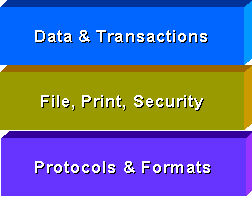
| Microsoft Year 2000 Readiness Disclosure
and Resource Center |
 |
 |
 |
| Integrate the Enterprise |
 |
3.
Introduction
Many
mission-critical systems, ranging from accounting to sales tracking
to air traffic control, were created years ago and were typically
written in COBOL. According to PC Week, there are over 100 billion
lines of this kind of code just in the United Statesùand it is not
going away anytime soon. The Gartner Group estimates that 80% of
today's legacy applications will be in use in the year 2000. While
the importance of these systems is not questioned, the problem of
getting the most from legacy systems with new technology has not
been easy.

Figure
1 Most legacy data is still stored in VSAM
files.
Replacing or re-engineering legacy applications are not
widely viewed as cost-effective because migrating them can be
complex, especially for non-relational systems. Moving legacy
systems to improved host-based technology has not occurred either.
For example, in the early 1980s, IBM released its DB2 relational
database management system (RDBMS) for the Multiple Virtual Systems
(MVS) operating system. Today, many organizations that use
mainframes are still dependent on IBM's Information Management
System (IMS) and Virtual Sequential Access Method (VSAM), as shown
in Figure 1. During 1996, over 2 billion IMS transactions were still
being processed daily, according to International Data Corp. The
reality is that legacy systems, in one form or another, still
provide most online transaction processing for many large
organizations.
Therefore, integration is the best strategy for leveraging
mainframe-based solutions with new technologies. This approach
maximizes the strengths of the existing architecture, allows use of
more efficient development languages, operating environments and
methodologies, and minimizes the impact of older technology or poor
design decisions made in the past. Using Microsoft« Windows« NT
Server as the middle-tier and Microsoft SNA ServerÖ for host
connectivity, companies can:
- Access files, relational and non-relational, on multiple
platforms.
- Leverage distributed processing between MVS and Windows NT.
- "Surf" files on Windows NT, MVS, and OS/400 from a browser.
- Leverage new screen-scrapping capabilities based on HTML.

Figure
2 Three levels for legacy integration.
You can
see in Figure 2 that there are three levels of integration, each
designed to maximize data processing assets. At the most basic level
are protocols and formats. Included are stable and well-defined
standards, such as LU6.2, SNA, and terminal emulators. Next are
multiple platforms sharing file and print services, with a single
cross-platform login to ease administration of security. The highest
level allows location independent data and transactions that support
different hardware platforms, and allow program interoperability to
provide the most open, flexible solution for legacy co-existence
with Intranet, Internet, and client/server systems.
By
extending legacy applications and using existing programmer
knowledge with the advantages of the desktop, corporations can enjoy
multiple benefits:
- Exploit new technologyùblur the lines between
disparate systems while simultaneously taking advantage of a
better infrastructure that delivers solutions faster with minimal
business disruption to create a competitive advantage.
- Preserve legacy investmentsùthrough integration,
legacy applications can continue to function while being evolved
into more flexible and robust systems. Accessing legacy systems
and data from networked PCs running custom applications or
browsers is essential today. This approach also allows businesses
to address any Year 2000 compliance issues in a
more orderly and cost-effective fashion.
- Reduce riskùintegration provides the opportunity to
support a migration strategy that can span years. Instead of
complete the migration in a single massive project, a step-by-step
approach using components helps to ensure success and minimize
risk. Once the basic access architecture is in place, needs are
prioritized to establish a sequential process, while adding new
business value to the organization as each step is completed.
Because the existing system is still active, a fallback is
possible, minimizing the impact on an organization.
- Reduce training and support expendituresùwith a
staff of many COBOL programmers, IS manages a substantial
technical and business advantage that needs to be re-deployed.
These groups of developers create high-quality software, and their
skillsùcode maintenance, business knowledge, structured
methodology, and quality focusùare incredibly valuable. While not
all programmers want to move to client/server or Web development,
integration allows companies to prioritize developer skills to
reduce retraining costs while maintaining high quality support.
- Improve corporate productivityùby using this
strategy, end users and developers are more productive because
multiple platforms can now operate together seamlessly. End users
can work with a consistent graphical user interface to find
information that is location independent, while developers can use
the technology to implement the best solution, regardless of the
client or server.
Microsoft and its partners
understand the importance of these systems to their customers and
together offer a collection of affordable, integrated solutions to
make accessing legacy systems easier, less expensive, more reliable,
and faster. In this paper, we also address common scenarios many
organizations are face and outline the technologies available to
achieve this goal.
|
|
|

